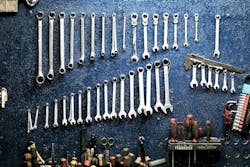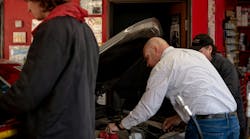The 2017 Cadillac Escalade updates include the availability of the rear camera mirror and automatic parking assist. There are also aesthetic updates for the Escalade, including two new exterior paint colors and a new 22- inch wheel design.
A new ESV edition Escalade offers a 14-inch-longer wheelbase (355 mm) and approximately 20 inches (508 mm) more in overall length, maximizing space for third row passengers and providing over two and a half times the cargo space behind the third row seat.
All models are offered with two-wheeldrive and four-wheel-drive drivetrains, powered by a 6.2L V-8 engine backed by an eight-speed automatic transmission. The 6.2L engine also delivers an EPA-estimated 22 mpg on the highway in Escalade/ESV 2WD and 20 mpg on the highway for Escalade/ESV 4WD.
The Escalade’s powerful and efficient 6.2L V-8 engine is rated at an SAE-certified 420 horsepower (313 kW) and 460 pound-feet of torque (623 Nm). The 6.2L features stateof-the-art technologies, including direct injection, active fuel management (cylinder deactivation) and continuously variable valve timing. Precisely controlled combustion enables an Escalade to run with a high compression ratio, which delivers great power and efficiency.
Cadillac’s Magnetic Ride Control, a self-acclaimed world’s fastest-reacting suspension system, is standard, delivering the precisely controlled driving performance. At its core, Escalade is an SUV with the capabilities of a full-size truck, enabling a trailering rating of 8,300 pounds on the standard model and an 8,100-pound rating on Escalade ESV.
New for 2017 is the availability of Cadillac’s industry-leading rear camera mirror. Utilizing a wide-angle camera mounted on the rear of the vehicle, the rear camera mirror system improves field of vision by an estimated 300 percent, or roughly four times greater than a standard rearview mirror — using streaming video to the function of a traditional rearview mirror, removing obstructions of passengers, headrests and rear seat infotainment systems and the vehicle’s roof and rear pillars.
Servicing the 2017 Cadillac Escalade
Cadillac advises that tires be rotated every 7,500 miles (12,000 km), along with performing any required services. Cadillac has two maintenance schedules: normal and severe. The normal service schedule is for vehicles that carry passengers and cargo within recommended limits on the tire and loading information label, are driven on reasonable road surfaces within legal driving limits and use the recommended fuel. The severe service schedule is for vehicles that are mainly driven in heavy city traffic in hot weather, mainly driven in hilly or mountainous terrain, frequently towing a trailer, used for high-speed or competitive driving or used for taxi, police or delivery service.When the “Change Engine Oil Soon” message displays, drivers should have the engine oil and filter changed within the next 600 miles (1,000 km). If driven under the best conditions, the engine oil life system may not indicate the need for vehicle service for up to a year. The engine oil and filter must be changed at least once a year, and the oil life system must be reset. If the engine oil life system is reset accidentally, service the vehicle within 3,000 miles (500 km) since the last service. Reset the oil life system when the oil is changed.
Normal Maintenance Schedule
Every 7,500 miles (12,000 km):- Rotate tires
- Check engine oil level and oil life percentage; if needed, change engine oil and filter, and reset oil life system
- Check engine coolant level
- Check windshield washer fluid level
- Visually inspect windshield wiper blades for wear, cracking or contamination; replace worn or damaged wiper blades
- Check tire inflation pressures
- Inspect tire wear
- Visually check for fluid leaks
- Inspect engine air cleaner filter
- Inspect brake system
- Visually inspect steering, suspension and chassis components for damaged, loose or missing parts or signs of wear
- Lubricate the suspension and steering components at least every other oil change (if equipped with grease fittings)
- Check restraint system components
- Visually inspect fuel system for damage or leaks
- Visually inspect exhaust system and nearby heat shields for loose or damaged parts
- Lubricate body components
- Check starter switch
- Check automatic transmission shift lock control function
- Check parking brake and automatic transmission park mechanism
- Check accelerator pedal for damage, high effort or binding; replace, if needed
- Visually inspect gas strut for signs of wear, cracks or other damage; check the hold-open ability of the strut; if the hold-open is low, service the gas strut
- Inspect sunroof track and seal, if equipped
- Verify spare tire key lock operation and lubricate, if needed
Every 22,500 miles (36,000 km) or every two years:
- Replace passenger compartment air filter
Every 45,000 miles (72,000 km):
- Inspect evaporative control system
Every 45,000 miles (72,000 km) or every four years:
- Replace engine air cleaner filter — if driving in dusty conditions, inspect the filter at each oil change or more often as needed
Every 97,500 miles (156,000 km):
- Change transfer case fluid, if equipped with 4WD
- Replace spark plug wires; inspect spark plug wires
Every 150,000 miles (240,000 km) or every five years:
- Drain and fill engine cooling system
Every 150,000 miles (240,000 km) or every 10 years:
- Visually inspect accessory drive belts for fraying, excessive cracking or damage; replace, if needed
Every five years:
- Replace brake fluid
Severe Maintenance Schedule
Every 7,500 miles (12,000 km):- Rotate tires
- Check engine oil level and oil life percentage; if needed, change engine oil and filter, and reset oil life system
- Check engine coolant level
- Check windshield washer fluid level
- Visually inspect windshield wiper blades for wear, cracking or contamination; replace worn or damaged wiper blades
- Check tire inflation pressures
- Inspect tire wear
- Visually check for fluid leaks
- Inspect engine air cleaner filter
- Inspect brake system
- Visually inspect steering, suspension and chassis components for damaged, loose or missing parts or signs of wear
- Lubricate the suspension and steering components at least every other oil change (if equipped with grease fittings)
- Check restraint system components
- Visually inspect fuel system for damage or leaks
- Visually inspect exhaust system and nearby heat shields for loose or damaged parts
- Lubricate body components
- Check starter switch
- Check automatic transmission shift lock control function
- Check parking brake and automatic transmission park mechanism
- Check accelerator pedal for damage, high effort or binding; replace, if needed
- Visually inspect gas strut for signs of wear, cracks or other damage; check the hold-open ability of the strut; if the hold-open is low, service the gas strut
- Inspect sunroof track and seal, if equipped
- Verify spare tire key lock operation and lubricate, if needed
Every 22,500 miles (36,000 km) or every two years:
- Replace passenger compartment air filter
Every 45,000 miles (72,000 km):
- Inspect evaporative control system
- Change automatic transmission fluid and filter
- Change transfer case fluid, if equipped with 4WD
Every 45,000 miles (72,000 km) or every four years:
- Replace engine air cleaner filter — if driving in dusty conditions, inspect the filter at each oil change or more often as needed
Every 97,500 miles (156,000 km):
- Replace spark plugs; inspect spark plug wires
Every 150,000 miles (240,000 km) or every five years:
- Drain and fill engine cooling system
Every 150,000 miles (240,000 km) or every 10 years:
- Visually inspect accessory drive belts for fraying, excessive cracking or damage; replace, if needed
Every five years:
- Replace brake fluid





